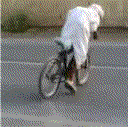Remember what I said about giving the tire a chance? Exactly the same thing applies to the suspension. Like sport tires don't need much chance to catch up, it's the same with sport suspension. That's why sportbikes tolerate bad riding, and why lazy riders say "I need a sportbike."
Today, though, we're going to concentrate on getting it right. And quite possibly the single most important factor in being able to ride any bike fast -- as in, just get on any bike and ride it fast -- is managing weight transfer.
Managing Weight Transfer
When you brake, the weight transfers to the front. The front of the bike goes down as the suspension compresses, and the rear comes up as the weight transfers off it.
When you're cornering, you're feeding the g-forces into both ends equally, and both ends of the bike compress from the cornering force.
When you roll on the throttle, you transfer weight to the back of the bike and away from the front. The front suspension extends as the weight comes off it, and the rear compresses as it starts to carry most of the weight of the bike.
Conventional Cornering
Let's first of all look at the conventional way of cornering. Not only does it waste half the traction circle, but it has even worse drawbacks:





So what's wrong with this?
Look at the front end -- it bounces up -- down -- up -- down -- up. At that back it's doing the same thing in reverse. All that bouncing up and down plays havoc with your traction and stability, as you're forever trying to keep the bike under control rather than going through the corner.
So when Mr. Hotshot-Squid says "I need more damping" or "I need better springs," what he usually means is "I bounce my bike." To make it worse, he's probably jabbing the brakes and whacking the throttle.
If you ride like this, no bike will handle to its potential. Sure, a sportbike will cope better because it has more damping, and that helps absorb the pogo-like motion the rider's putting into it, and that takes us back to "I need a sportbike." But even sportbikes handle better when ridden properly...
Doing It Right
Doing it right is really very simple. All we have to do is leave out the "let off", and smooth the transition from one state to the next. We go from full throttle, squeeze the brakes to braking, ease off the brake to cornering, roll on the throttle to accelerating, and unwind the corner at the same time.




Looking at what the bike does now, you can see a smooth flow: the front comes down smoothly and rises smoothly, with no big movements to absorb. Not only is the bike under control, but the suspension is free to soak up real bumps in the road, and so the bike doesn't skitter or bounce across the road.
This way, you can make any bike handle. I've passed a CBR600F2 in the depths of Deals Gap on a stock Suzuki Intruder, and there just isn't any bigger handling difference than that.
Does a sportbike handle better? Sure it does. A sport suspension "absorbs" changes quicker, so you can transition from braking to cornering to acceleration more quickly. You can be smooth much more rapidly -- the bike doesn't need as long to catch up -- so you don't waste any time making transitions.
Bounce-back
There's an added difficulty when you're sport-riding a bike with a non-sport suspension and long fork travel, like a cruiser, DP bike, or relaxed standard. The damping and suspension design of a sportbike eliminates this effect almost completely. It complicates things a bit, but to manage your weight transfer fully, you have to take it into consideration.
As you brake, the front "rushes" down -- it gets momentum, so after you let off the brakes it still keeps going for a bit. So ease off the brakes slowly to give it a chance to slow down at the end. This is where "I need more damping" is true, but doesn't have to be because the rider can allow for it.
As a point of interest, it's usually on the "rush" that bikes with soft suspension bottom the front end. A rider who regularly bottoms the front end probably hasn't taken this into account.
Again -- always give the bike a chance to catch up, and some bikes need more chance than others.
From TrackDoD Novice Group Orientation



No comments:
Post a Comment